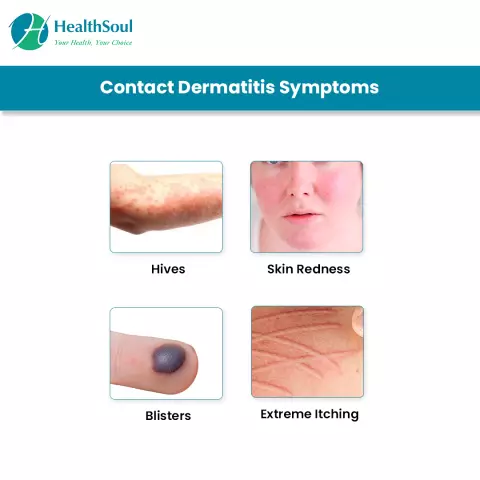- Author Rachel Wainwright [email protected].
- Public 2023-12-15 07:39.
- Last modified 2025-11-02 20:14.
Dermatitis

Dermatitis is an inflammation of the skin. The condition of the skin is directly related to the state of the body's immune and endocrine systems, and it reacts sensitively to all changes occurring in it, therefore dermatitis can be an independent disease, or it can be a skin manifestation of general pathology.
Types of dermatitis
The following types of dermatitis are distinguished:
- Contact (simple) dermatitis is an inflammation of the skin that occurs in response to direct contact with an irritant. Any substance can act as an irritant if there is an individual sensitivity to it. There are also a number of substances that cause dermatitis in all, without exception, such irritants are called obligate. Obligate irritants include caustic alkalis, acids, some plants (nettle, euphorbia, etc.), exposure to high and low temperatures, skin trauma, etc.;
- Toxidermia is a skin manifestation of a toxic-allergic reaction of the body in response to the ingestion of an allergen. A typical example of toxidermia is urticaria.;
- Atopic dermatitis (neurodermatitis). Nervous-allergic form of dermatitis, prone to chronic recurrent course;
- Seborrheic dermatitis. This dermatitis most often manifests itself on the face, in the area of the wings of the nose, on the forehead at the border of hair growth, on the back surface of the auricles, on the eyebrows. Caused by a yeast-like fungus, has a chronic course;
- Other types of dermatitis. These include rosacea, acne, pimples, eczema, etc. Usually these forms are considered as separate diseases.
By the nature of the course, dermatitis can be acute and chronic. Acute dermatitis is characterized by a sudden onset, a violent course with bright manifestations, and they usually respond well to treatment. With an unfavorable outcome, acute dermatitis can become chronic. Chronic dermatitis is characterized by a prolonged course with relapses, often with pronounced seasonality. They are difficult to treat.
According to the prevalence, dermatitis can be local (local), or diffuse (general). Simple (contact) dermatitis is usually limited to local manifestations that occur in the area of direct exposure to the irritant. Toxic-allergic and neuro-allergic forms are characterized by a diffuse nature.
Dermatitis symptoms
The symptoms of dermatitis vary considerably depending on the form of the disease, but for all forms the main symptom is the appearance of various inflammatory elements on the skin: rash, papules, pustules, erythema, peeling scales, etc. Very often, the appearance of these elements is accompanied by itching, sometimes quite painful. Soreness occurs less often. The characteristic symptoms of dermatitis also include impaired sensitivity in the damaged areas. Sensitivity can be increased, or vice versa, decreased to the point of complete absence. Dermatitis on the face is more likely than others to have a seasonal tendency - exacerbation in the cold season and remission in summer.

Toxic forms of dermatitis can be accompanied by a general deterioration in well-being: fever, the appearance of musculoskeletal and headaches, and a loss of strength. However, more often the symptoms of dermatitis are limited to local, skin manifestations.
Dermatitis is very common in children, which is associated with age-related imperfection of the immune system, and in connection with these susceptibility to allergies. One of the most common forms of dermatitis in children is exudative diathesis, which is allergic in nature. Despite the fact that this is a common pathology, and dermatitis in children is rather violent, they rarely have a protracted nature, and usually heal well after the removal of the damaging factor.
Dermatitis diagnostics
Diagnosis of dermatitis usually does not present any difficulties, and diagnostic measures are necessary to identify the form of the disease, since the treatment of dermatitis of various types can radically differ in its approach.
Diagnostics includes:
- Scraping from the affected skin surface followed by laboratory examination (histology, bacteriological examination);
- Immunological examination in order to identify the allergen and a general assessment of the state of the body's immune system;
- Biopsy as needed
- Expanded blood and urine tests;
Dermatitis treatment
Treatment for dermatitis depends on its form, and is always selected individually.
It is necessary to start treatment of dermatitis by determining the cause. It is necessary to identify the irritant (allergen, toxic substance, microbial pathogen) and eliminate it. If the irritant is not identified, as is often the case with allergic and especially neuro-allergic dermatitis, the treatment will be only symptomatic, i.e. aimed at eliminating symptoms and maintaining the remission stage.
Treatment of dermatitis is conservative and consists of local and general therapy. Acute dermatitis and dermatitis in children, as a rule, are treated only with local remedies, and chronic forms require a combination of general and local therapy.
Local treatment of dermatitis consists of treating the affected skin. Skin rashes are treated with anti-inflammatory and antibacterial drugs in the form of talkers, powders, ointments, solutions - depending on the form of the inflammatory element and its stage. Dermatitis on the face (seborrheic) is treated with antifungal ointments. Chronic dermatitis is treated with corticosteroid anti-inflammatory drugs, acute dermatitis is treated with aniline dyes. Deep ulcerative lesions are treated in a hospital setting.
The general treatment for dermatitis is to take immunomodulatory, antihistamines, sedatives, depending on the cause of the disease. It is also necessary to eliminate all sources of chronic infection, such as teeth destroyed by the carious process, chronic sinusitis, tonsillitis, etc.
YouTube video related to the article:
The information is generalized and provided for informational purposes only. At the first sign of illness, see your doctor. Self-medication is hazardous to health!






